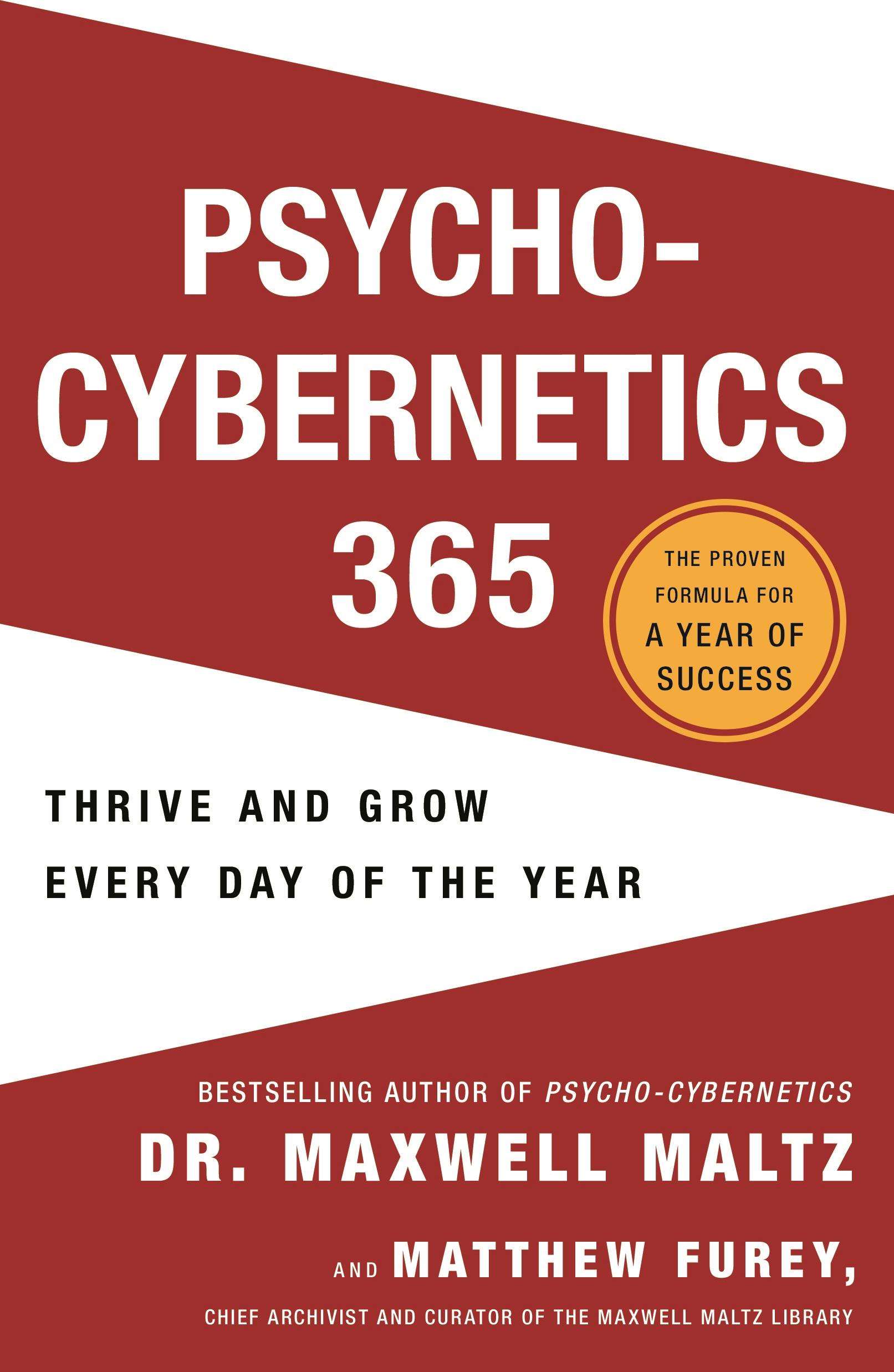
In 1960, Dr. Maxwell Maltz introduced his revolutionary theory of psycho-cybernetics: the science of using self-image psychology, visualization and action to achieve your goals. These ground-breaking concepts established him as a pioneer in the self-development field and transformed the lives and careers of people all over the world. In Psycho-Cybernetics 365, Matthew Furey, a Maltz scholar and president of the Psycho-Cybernetics Foundation, decodes quotes and ideas from a variety of Dr. Maltz’s works with practical and inspiring insights to help readers implement the unique psycho-cybernetics principles of visualization and goal-striving to reshape their lives and increase their achievements each day of the year. Read an excerpt below.
Day 1: “Discovery of the self-image represents a breakthrough in psychology and the field of creative personality.”
When Maxwell Maltz wrote his flagship book, Psycho-Cybernetics, in 1960, he combined the word “psycho” for mind with the word “cybernetics,” a term stemming from the Greek that means “to steer or govern a ship to port.” Even though Dr. Maltz’s career began as a cosmetic surgeon, he saw personality changes appear after people noted the changes in their facial features. Although most people Maltz operated on experienced an immediate improvement in their personalities, some of his patients showed no improvement. The lack of changes in the personalities of these patients perplexed Dr. Maltz, which led him to the discovery of self-image psychology and the science of cybernetics. He learned that just as a thermostat is programmed cybernetically to maintain a certain temperature, human beings are programmed to succeed or fail based on the mental imagery or “software” installed in the mind. This software, however, is malleable. Just as the temperature on a thermostat can be altered, so can a human being’s personality, actions, attitude, and level of accomplishment. These positive changes occur by altering and im- proving the mental pictures you focus on each day.
Dr. Maltz noted, “When you change a man’s face, you almost invariably change his future.” But it is also the image that creates the real change. Some of his patients, although their faces were changed, still carried with them the scars of their internal wounds.
Your self-image is the key that unlocks and drives your personality, your feelings, your behavior, and your results. It is the blueprint that tells your brain and nervous system what is and isn’t possible for you. This blueprint can be changed by shifting how you use your imagination. How you see yourself in your mind’s eye changes how you feel and the results you experience in life. As soon as you change your mental image about the future from one of fear to one of courage and confidence, your feelings automatically improve.
You can learn to expand your self-image beyond the limitations and boundaries of what you thought was possible. Your new self-image, the way you see yourself, will break down barriers and open the door to new capabilities, new talents, and the achievement of your goals.
As you change your mental picture, you will see that you have the power to change your life for the better.
Begin your journey through psycho-cybernetics by asking yourself these questions:
Is there an uncomfortable image playing in my mind?
How do I feel when I picture it?
What would happen if I changed that image to one that is positive?
What did I notice when I changed it?
Day 2: “Success—one goal at a time.”
Did you know that within your brain, there is an automatic guidance system that works subconsciously to help you reach a goal? How this mechanism works for you depends upon how you picture things in your mind. You are the one who will set the goals and decide the outcomes. You can have a sense of what you want, but once you set a goal, your internal mechanism will begin to find ways to achieve it. Start with a goal for today—something you want to accomplish or create before the day is done. Focus on it, and then do what you focused on.
Setting a goal using psycho-cybernetics is easy when you focus on one goal for each day. Eventually, when you have momentum, you can focus on more goals, including longer-range goals. Anyone can make a long list of goals, but too many goals can confuse the mind. Too many goals or too many long-term goals can overload what Dr. Maltz called the Creative Mechanism, causing it to jam. Your initial goal can be as simple as seeing yourself with kind eyes or seeing the times in your life when you were happy, energized, and creatively alive. Remember, when you change the images you focus on, you change your self-image, leading to changes in your results. Start with a simple daily goal first, and greatness will come from it.
Day 3: “Steer your mind to a useful goal.”
The physical brain and body function similar to a machine. No, you are not a machine, but when you use your mind effectively, automatic changes happen inside the brain and nervous system, much like a machine that is programmed correctly. The change in you does not occur through willpower but through the proper use of your imagination. As the saying goes, in the battle between imagination and willpower, imagination always wins. You can easily walk a plank that is a few inches off the ground, but if you put the plank twelve feet above the ground, you begin to imagine falling, which causes you to become paralyzed with fear. This is an example of why imagination is your greatest tool. When you direct your imagination toward positive goals, it works for you. When you use it to picture something negative, it works against you.
“This same Creative Mechanism within you can help you achieve your best possible ‘self’ if you form a picture in your imagination of the self you want to be and see yourself in the new role. This is a necessary condition for personality transformation, regardless of the method of therapy used. Somehow, before a person can change, he must see himself in a new role.” —Maxwell Maltz, Psycho-Cybernetics: Updated and Expanded
Day 4: “Dehypnotize yourself from false beliefs.”
We may not realize it, but to some extent, we all are hypnotized in our day-to-day lives. We are told a multitude of things about our world, about other people, and about ourselves that we unconsciously buy into and believe to be factual. Some of these beliefs come from our earliest experiences with family members, teachers, and peers, including situations we don’t even remember. As children, we absorb messages and ideas before we learn to speak, and throughout our lives, we tend to look to those outside of ourselves to define who we are and what we are supposed to think. If what we think about ourselves is helping us get the results we want, there’s nothing to change. But if what we believe to be true is holding us back, we can eradicate those false ideas and beliefs by taking in new information and using our imagination in an empowering way.
In this first week, begin to look at the false ideas or limiting beliefs you have bought into about yourself. Begin by choosing one aspect about yourself you want to question or challenge.
Ask yourself, “How do they know? What if they were wrong? What if all I had to do was form a new mental picture and begin to practice?”
Start with something simple, such as making your bed today. You may resist this simple task and think it is tedious. But before you make your bed, see yourself making it with a smile on your face. Note the changes in your experience after you do this.
Day 5: “Compete with yourself.”
There is an expression in AA (Alcoholics Anonymous) that you should never measure your insides by someone else’s outsides. There is great wisdom in this because you never know all the details about another person’s life. When we dwell on external observation alone, we buy into illusions that don’t hold up under scrutiny.
“Inferiority and superiority are reverse sides of the same coin. The cure lies in realizing that the coin itself is spurious. The truth about you is this: You are not inferior, you are not superior, you are you.” —Maxwell Maltz, Psycho-Cybernetics
The takeaway from this quote is that you do not need to compete with anyone other than yourself. You are a unique individual created in the image of God. So, rather than looking outside and comparing yourself to what others have or do, concentrate on a goal that appeals to you. Be your own competition. Compete with yourself, bettering your previous best.
Day 6: “Procrastination can drain your energy.”
You can’t be happy for long if you continually put off until tomorrow what you can and ought to do today. Most of the time, when you put off something that you want or need to do, you lose energy. On the other hand, taking a break to let your subconscious do its job leads to ideas that give you more energy. In this case, you aren’t really procrastinating. You are using the subconscious part of the creative process. When you understand how the process works, you don’t beat yourself up when you take a break because you realize that your best ideas often come when you aren’t consciously working on them.
Taking a walk, cleaning a room, jumping in the shower, and making time for a nap are all activities that may seem frivolous, but trained eyes see it differently. These eyes can see the process you are following, one of letting your internal Success Mechanism help you reach your goal. Negative procrastination drains you of energy, whereas creative procrastination gives you the energy to accomplish your objective.
Day 7: “When making changes, reserve judgment for a minimum of twenty-one days.”
Rome wasn’t built overnight. Keep this in mind as you begin to change your self-image. It typically takes twenty-one days for an old mental image to be transformed into a new one. This doesn’t mean you won’t see any changes before then. You probably will, especially when you focus on taking action that leads to accomplishing a daily goal. Start with one goal, one objective. Practice seeing yourself at the end of the day with your goal accomplished.
It is often easier to look at other people and think about how these people could change their ways with this book. Avoid this tendency. Take care of yourself first. Approach this new process without questioning whether or not change is even possible. Allow change to come of its own accord, without effort, just as you would if you planted a seed in fresh soil. A new mental picture is the same as that seed. Plant it, water it, then leave it alone so nature can do her work. You’ll be amazed at how this same process that works with plants and seeds works with you.
Copyright © 2025 by Matthew Furey

Maxwell Maltz was one of the most important and renowned authors in the field of psychology. His books include Psycho-Cybernetics, Creative Living for Today, The Magic Power of Self-Image Psychology, and the bestseller Dr. Pygmalion. He was also an internationally renowned professor and lecturer.










